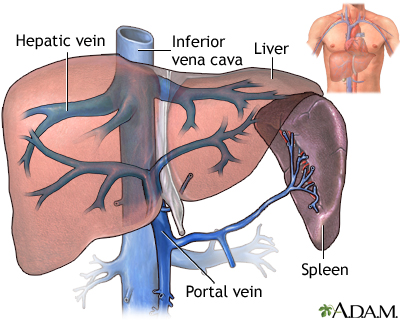Portacaval shunting
Portacaval shunting is a surgical treatment to create new connections between two blood vessels in your abdomen. It is used to treat people who have severe liver problems.
Description
Portacaval shunting is major surgery. It involves a large cut (incision) in the belly area (abdomen). The surgeon then makes a connection between the portal vein (which supplies most of the liver's blood) and the inferior vena cava (the vein that drains blood from most of the lower part of the body.)
The new connection diverts blood flow away from the liver. This reduces blood pressure in the portal vein and decreases the risk for a tear (rupture) and bleeding from the veins in the esophagus and stomach.
Why the Procedure Is Performed
Normally, blood coming from your esophagus, stomach, and intestines first flows through the liver. When your liver is very damaged and there are blockages, blood cannot flow through it easily. This is called portal hypertension (increased pressure and backup of the portal vein.) The veins can then break open (rupture), causing serious bleeding.
Common causes of portal hypertension are:
- Alcohol use causing scarring of the liver (cirrhosis)
Alcohol use
Alcohol use disorder is when your drinking causes serious problems in your life, yet you keep drinking. You may also need more and more alcohol to f...
 ImageRead Article Now Book Mark Article
ImageRead Article Now Book Mark ArticleCirrhosis
Cirrhosis is scarring of the liver and poor liver function. It is the last stage of chronic liver disease.
 ImageRead Article Now Book Mark Article
ImageRead Article Now Book Mark Article - Blood clots in a vein that flows from the liver to the heart
Blood clots
Blood clots are clumps that occur when blood hardens from a liquid to a solid. A blood clot that forms inside one of your veins or arteries is calle...
 ImageRead Article Now Book Mark Article
ImageRead Article Now Book Mark Article - Too much iron in the liver (hemochromatosis)
- Hepatitis B or hepatitis C
Hepatitis B
Hepatitis B is irritation and swelling (inflammation) of the liver due to infection with the hepatitis B virus (HBV). Other types of viral hepatitis ...
 ImageRead Article Now Book Mark Article
ImageRead Article Now Book Mark ArticleHepatitis C
Hepatitis C is a viral disease that leads to swelling (inflammation) of the liver. Other types of viral hepatitis include:Hepatitis AHepatitis BHepat...
 ImageRead Article Now Book Mark Article
ImageRead Article Now Book Mark Article
When portal hypertension occurs, you may have:
- Bleeding from veins of the stomach, esophagus, or intestines (variceal bleeding)
- Buildup of fluid in the belly (ascites)
Ascites
Ascites is the build-up of fluid in the space between the lining of the abdomen and abdominal organs.
 ImageRead Article Now Book Mark Article
ImageRead Article Now Book Mark Article - Buildup of fluid in the chest (hydrothorax)
Portacaval shunting diverts part of your blood flow from the liver. This improves blood flow in your stomach, esophagus, and intestines.
Portacaval shunting is most often done when transjugular intrahepatic portosystemic shunting (TIPS) has not worked. TIPS is a much simpler and less invasive procedure.
Transjugular intrahepatic portosystemic...
Transjugular intrahepatic portosystemic shunt (TIPS) is a procedure to create new connections between two blood vessels in your liver. You may need ...

Risks
Risks for anesthesia and surgery in general are:
- Allergy to medicines, problems breathing
- Bleeding, blood clots, or infection
Risks for this surgery include:
- Liver failure
- Hepatic encephalopathy (a disorder that affects concentration, mental status, and memory -- may lead to coma)
After the Procedure
People with liver disease are at a much higher risk for complications after surgery.
People with severe liver disease that is getting worse may need to be considered for liver transplant.
Reviewed By
Michael M. Phillips, MD, Emeritus Professor of Medicine, The George Washington University School of Medicine, Washington, DC. Also reviewed by David C. Dugdale, MD, Medical Director, Brenda Conaway, Editorial Director, and the A.D.A.M. Editorial team.
Dudeja V, Ferrantella A, Fong Y. The liver. In: Townsend CM Jr, Beauchamp RD, Evers BM, Mattox KL, eds. Sabiston Textbook of Surgery. 21st ed. St Louis, MO: Elsevier; 2022:chap 54.
Rosemurgy AS, Sucandy I. Techniques of portosystemic shunting: selective and nonselective shunts. In: Jarnagin WR, Allen PJ, Chapman WC, et al, eds. Blumgart's Surgery of the Liver, Biliary Tract, and Pancreas. 7th ed. Philadelphia, PA: Elsevier; 2023:chap 84.
Shah VH, Kamath PS. Portal hypertension and variceal bleeding. In: Feldman M, Friedman LS, Brandt LJ, eds. Sleisenger and Fordtran's Gastrointestinal and Liver Disease. 11th ed. Philadelphia, PA: Elsevier; 2021:chap 92.

 All rights reserved.
All rights reserved.